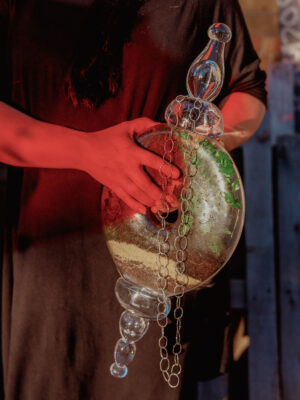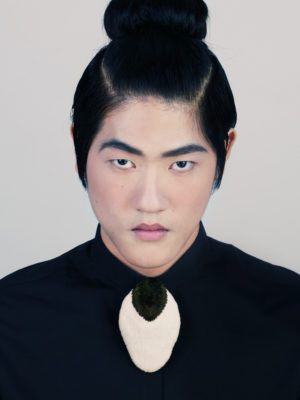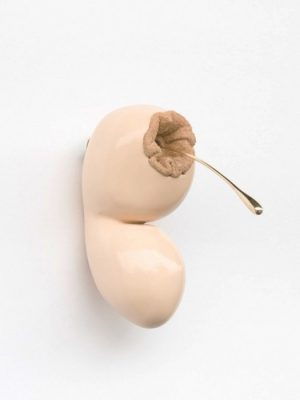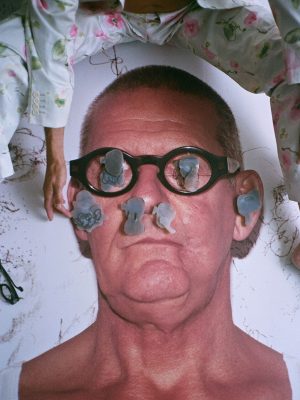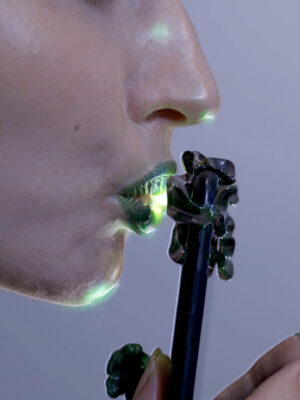Current Obsession: We are currently sitting in your studio at The Garage, how did you end up here and what is the history of this place?
Matilda Kästel: Fredrik Nielsen (Editors’ note: one of the founders of The Garage Stockholm) and I talked about it today actually. I met Fredrik when I first started blowing glass. I did an internship at Steninge Slott in Märsta, Sweden and he was working there. It was a hot shop that existed up until a few years ago. At the time that I met him, I was still studying. But well, since the glass scene in Sweden is quite small, we just kept bumping into each other every now and then. And then in 2015, he posted on Facebook that he was starting a glass blowing studio and there would be some studios for rent. I just called him and moved in right away!
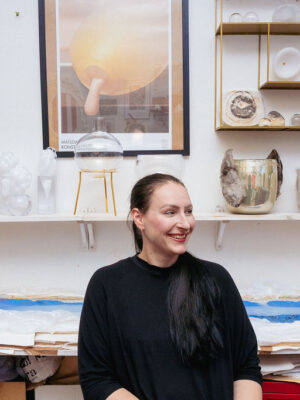
CO: You mentioned that the glass scene in Sweden is a bit small. Could you give us a little insight into it? Is finding your place within it challenging?
MK: Well, yes, it is challenging. I wish there were more exhibition opportunities. There are very few places that show material-based art in Stockholm. Especially now, after Gustavsbergs Konsthall was forced to close. It was an important platform for contemporary craft. Except that, glass is a difficult material to get your hands on. You need very specific equipment like furnaces and kilns that are expensive. Also, the scale is big, you need space and really good electricity too.
CO: So, how come that you’ve ended up working with glass regardless? What is the story behind it?
MK: For me, it was actually a family story. I come from a family of German glass blowers that came to Sweden in the 1850s to blow glass. I have always listened to all these stories that were told at home. My great grandfather was the last one from the family to blow glass. Then I showed up fifty years later.
It was through these stories that I got the idea that you actually can work with glass. Later, I went to art school and I sculpted a lot. I remember thinking to myself that sculpting in glass must be the most amazing thing to do. And it is! (laughs) It is just a magical material. Transparent, soft and hard at the same time… It never stops being interesting to me.
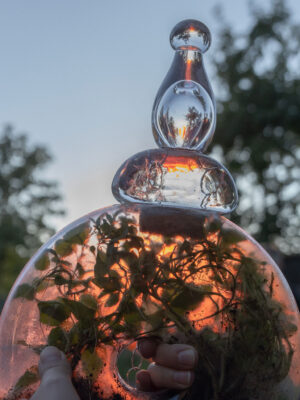
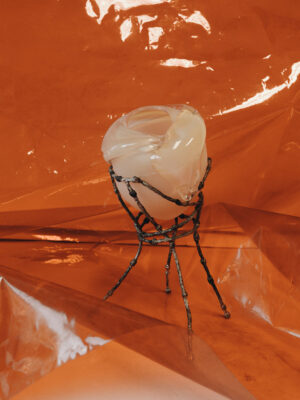
CO: Have you ever got the chance to work with your great grandfather or see him in the process of blowing glass?
MK: I have only seen the pictures. They were blowing window glass, firstly in Småland, at Gyllenfors Glassworks, and then they went on to Värmland. In 2014, I got to try to blow a window glass myself at a factory in France, in one of the few workshops where they still make it in the traditional way. That was an amazing experience. There was a four-meter deep shaft down to the basement and you basically had to hang the glass down that shaft. I have a little bit of vertigo, so I ended up thinking that I would fall down the shaft. But then I got the advice that if you lose your balance, just drop everything, the glass and the pipe, don’t fall in the hole yourself. (laughs) So, in the end, I was fine!
CO: Looking at your work, one can definitely see the sculptural influence in it. Could you talk about your artistic practice and its tipping points?
MK: My biggest interest is sculpture, no matter the material. When I came to the Ceramics & Glass department at Konstfack, I felt I was free to do whatever I wanted, which made me investigate my interests more. My work has become a lot about the glass itself, but also about what it means to be a human and the fleeting state of things. It also speaks about femininity and feminism. I feel that there are so many things that affect women in a way that they don’t affect men. Also, reflecting on what is happening now, for instance with the abortion law in Texas, just tells me that there is still something off with the perception of women in society. And that will always be something I will be interested in and vocal about. I’ve worked with themes like objectification, motherhood and relationships, depending on what I’ve been going through in my own life.
One example is the interactive sculpture Oh La La from 2019, which is made from cast tongues in glass and silicone, which lick each other when you turn the wheels. It is made to be funny, a bit icky and at the same time a love letter to my husband in sculptural form.
I am also part of the feminist glass collective called BOOM! And to create an overall more equal and including glass scene is one of our main goals.
“My work has become a lot about the glass itself, but also about what it means to be a human and the fleeting state of things. It also speaks about femininity and feminism. I feel that there are so many things that affect women in a way that they don’t affect men. Also, reflecting on what is happening now, for instance with the abortion law in Texas, it just tells me that there is still something off with the perception of women in the society.”
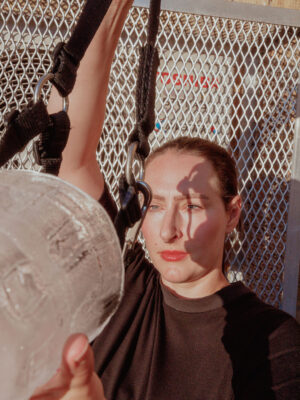
CO: Are you speaking from your own experience?
MK: Yes. Glass is still a really male dominated area. The discussions usually revolve around the scale of the work and in that kind of setting muscles mean something. The stronger you are, the bigger the work you can make, and smaller stuff might not count in the same way.
CO: It is quite interesting to look at it from this perspective. My personal perception has always been that glasswork requires a lot of collaboration, trust and understanding between the two co-working people.
MK: Yes, definitely. And BOOM! has been a lot about that. We want to create a safe space and a platform where we can support each other, but also other women and young people who would like to work with glass but don’t have access to it.
There are five women in the collective: me, Ammy Olofsson, Nina Westman, Erika Kristofersson Bredberg and Sara Lundkvist who started the group. We started to meet up once a week and discuss different subjects and just realized that we had a lot to talk about and that we share a lot of ideas and sentiments about today’s glass scene. It has been six years since these meetings and we are still working together.
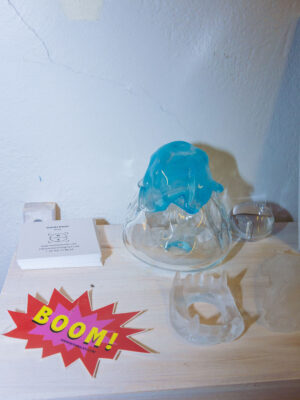
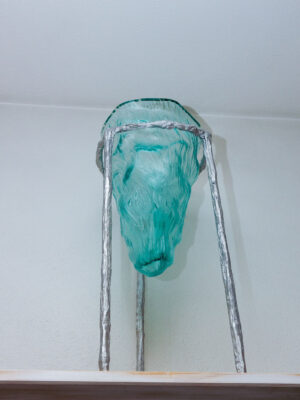
CO: I visited some of the BOOM! exhibitions and it really seems that you also do a lot of community and activist work through working with the public and organizing workshops. And in my opinion that sets a great example and encourages women working in not only glass but craft in general.
MK: That is another thing we talked about. When we were in our education, we never heard of any women working in glass, so we never had any female role models really. Of course, there were female glass blowers but no one ever told us about them. Over time we have found them. Like Ulla Forsell, who is an honorary member of BOOM! She started her glass workshop in the seventies. Now she is seventy-seven years old and is still blowing glass. So yes, the supportive community is definitely a greater purpose of BOOM!
CO: Also, what I observe in your practice is that you don’t restrict yourself to glass as the only medium and you have a number of collaborations with different artists as well. For example the collaboration with jewellery artist Jenny Edlund. How do these collaborations come about?
MK: I have a big interest in collaborating. I think it is a great opportunity to learn and I am always curious about new materials and what else I can do. But the collaboration itself is usually just a matter of context. I am a member of Konsthantverkarna in Stockholm which was organizing an exhibition in 2018 called Dialogue. The concept was to pair up with another member and work together. Few years prior to that, I saw Jenny’s exhibition and I knew that the feminist agenda was a common interest. We still work together every now and then.
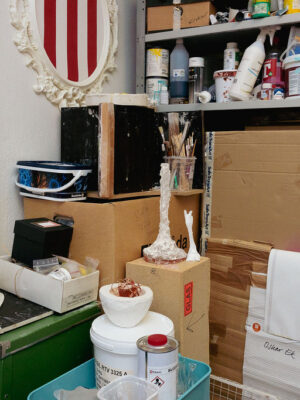
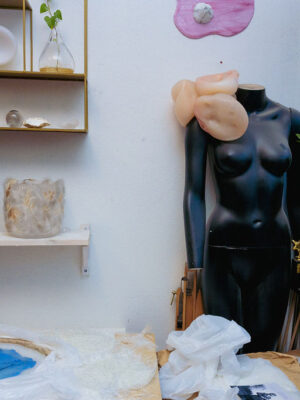
CO: What are you working on now? Can you tell us a little bit about what you are planning to exhibit during Stockholm Craft Week?
MK: During Stockholm Craft Week I will be part of the exhibition TAKEAWAY at Gallery Duerr. During the pandemic, I made a new piece, a pangolin, which is one of the animals suspected of having spread the coronavirus to humans. I am actually planning to work on a series of large scale ceramic sculptures in the same style over the next six months. The working title is Gymnastic Animals, so getting a lot of gymnastic equipment is the next step! (laughs) Also, Nina Westman and I are doing a glass blowing demo, here at The Garage during the last day of Stockholm Craft Week.
This article was commissioned by Stockholm Craft Week 30 September-3 October 2021, and produced by Current Obsession, Veronika Muráriková and Lizzie Abbott.
Photographs by Michelle Bondulich.
